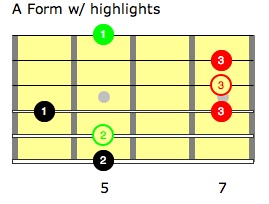How to Move The A form Arpeggio to other Keys:
The A form arpeggio gets its name because it comes from the open position A major chord shape. Look at the diagrams below and note how the A chord shape is contained in the A form arpeggio. Fingered notes are in red and open strings are in green. Don’t dismiss the open strings they are also part of the shape.
Like all the CAGED arpeggio forms this form, or shape, is moveable and can be played in any of the 12 keys available to us. This is done by placing the root notes, the #’s in circles, on the note name of the desired key.
Lets try moving this form to the key of B Major:
Notes in a B major chord – B D# F#
- Lets use the root note from our A form that is located on the 5th string. It is played usually with the 2nd finger.
- Find a B on the Low A string. You can use the fretboard pic below as a reference. As you see you’ll can find a B at the 2nd fret of the low A string.
- Place your 2nd finger on that note at the 2nd fret of Low A and proceed to play thru your A form arpeggio from that point in the shape. You are now playing your A form in the Key of B major.
Now let’s put the A form in the key of E.
- This time lets use the root note located on the G string.
- Find an E on the G String and place your 3rd finger on it. Using the fretboard pic above for reference you’ll find that there is one on the 9th fret.
- Continue playing your arpeggio from this point in the shape up and down. You are now in the key of E major. It’s that simple.
*At first it may still be confusing why this works. For now just know that it does and over time with more use the fretboard will start to make more sense. The important thing is to apply this knowledge regularly.
Previous Lesson: A Major Form Arpeggio
Next Lesson: G Major Form Arpeggio
 Copyright secured by Digiprove © 2014 jeff lauffer
Copyright secured by Digiprove © 2014 jeff lauffer 





Leave a Reply